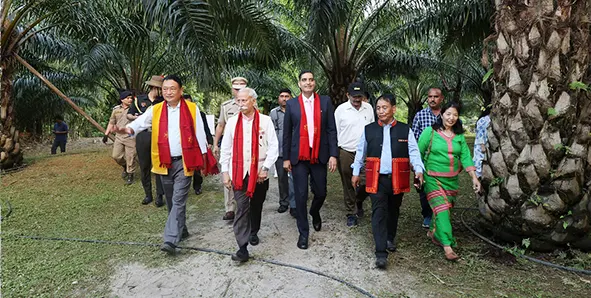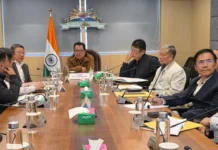PASIGHAT, 6 Oct: “Oil palm cultivation is not merely an agricultural activity but a vision for economic growth, farmer empowerment, and national self-reliance,” said Governor KT Parnaik during a visit to the 4-hectare oil palm farm of progressive farmer Miti Megu Perme in Bosi Didum village near here in East Siang district on Monday.
During his visit, the governor interacted with Perme, other local farmers, and departmental officials, thereby obtaining firsthand insights into the farm’s operations.
The governor noted that India, despite being one of the largest consumers of edible oil, continues to depend heavily on imports. “Promoting oil palm, therefore, is a strategic step by reducing import dependency, strengthening the rural economy, and ensuring price stability for consumers,” he said.
Highlighting the state’s potential, Parnaik said that Arunachal Pradesh’ fertile soil, favourable climate, and abundant rainfall make it ideal for oil palm plantations. “For farmers, it offers a steady income, long-term security, and better returns than most other oilseeds, while also creating opportunities for agro-based industries,” he said.
Parnaik commended the state government for prioritizing oil palm cultivation, saying that the policy not only aims to enhance farmers’ livelihoods and generate employment but also supports the national goal of self-reliance.
In doing so, it is attracting investment, improving rural infrastructure, and building stronger market linkages, he said.
The governor informed that Arunachal produced over 5.19 lakh metric tonnes of food grains, nearly 15,000 metric tonnes of pulses, and over 39,000 metric tonnes of oilseeds last year. Fifteen soil testing laboratories have been set up, and more than 1.3 lakh soil health cards have been issued. Oil palm cultivation has already expanded by 4,690 hectares, benefiting nearly 2,000 farmers under the ‘Per Drop More Crop’ scheme, he said.
Looking ahead, the governor said that the state has set an ambitious target of bringing 35,723 hectares under oil palm cultivation by 2025-26. The establishment of the country’s first crude palm oil mill in Roing and the new factory coming up at the Industrial Growth Centre in Niglok are boosting farmers’ confidence and ensuring sufficient processing capacity for the future, he said.
Perme informed that the farm was established in 2017 and began harvesting in 2021. She said that palm oil is harvested three to four times a month, yielding 2 to 3 tonnes per harvest. She said also that the recent establishment of the palm oil factory in Niglok has steadily increased the demand for palm oil, providing a strong market for local farmers.
East Siang DC Sonalika Jiwani said that, given the rising demand, oil palm cultivation is proving to be highly remunerative and holds significant potential to boost the local economy, providing sustainable income opportunities for farmers in the region.
MLAs Ninong Ering and Tapi Darang, SP Pankaj Lamba and District Agriculture Officer Opang Moyong were also present during the governor’s farm visit. (Raj Bhavan)




